|
Installation of the targets into the Genesis concentrator
sample collection device was completed August 21, 2000 at
the Los Alamos National Laboratory. It was accomplished by
two LANL mechanical technicians and checked by a payload quality
assurance support person from JPL.
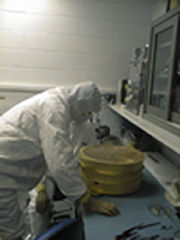 Workers
in the LANL assembly area wore full body suits and cleanroom
boots, rather than the smocks that are typically used during
spacecraft component construction. This step was taken to
meet stringent cleanliness guidelines for Genesis collector
materials. A particle counter was used to monitor room cleanliness
throughout the two-day procedure. Workers
in the LANL assembly area wore full body suits and cleanroom
boots, rather than the smocks that are typically used during
spacecraft component construction. This step was taken to
meet stringent cleanliness guidelines for Genesis collector
materials. A particle counter was used to monitor room cleanliness
throughout the two-day procedure.
The concentrator is shaped like an open-topped cylinder.
It is positioned under the sample collection arrays in the
canister. Once the arrays are swung out, solar wind will be
able to flow directly into the concentrator.
Solar wind consists mainly of hydrogen and helium, the two
lightest elements. The Genesis scientists are interested in
collecting samples of all the other elements in solar wind,
from lithium to uranium. Their abundances in the solar wind
are very low. Unfortunately, one of the most interesting elements,
oxygen, tends to have high backgrounds in almost all materials.
It is thus desirable to increase the implanted solar wind
over this oxygen background. The Genesis concentrator does
this by first applying an electric field through a grid or
screen that repels the ionized hydrogen. The incoming solar
wind particles are reflected near the back of the parabolic
concentrator surface onto a target. The back surface is not
smooth, because that would reflect sunlight onto the target,
making it way too hot. Instead, the mirror is milled into
tiny micro-steps so that the sunlight is reflected straight
back out the way it came in. The microsteps (below) do not
prevent the mirror from directing ions toward the target because
the ions do not actually bounce off the mirror. Rather, they
feel the repulsive force of the mirror and are turned around
some distance above the surface. At this distance the mirror
still has a force field similar to a completely smooth surface!
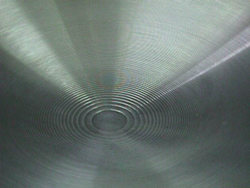 |
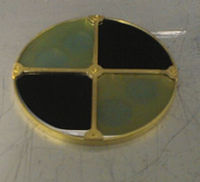 The
target onto which the solar wind ions will be concentrated
is made of four individual quadrants. The two that appear
greenish in the photo are silicon carbide made by Cree Research,
Inc. The upper dark quadrant is C-13 enriched diamond made
by Raytheon. The other dark quadrant is semiconductor-grade
silicon with an amorphous diamond coating made by Sandia National
Laboratory. The
target onto which the solar wind ions will be concentrated
is made of four individual quadrants. The two that appear
greenish in the photo are silicon carbide made by Cree Research,
Inc. The upper dark quadrant is C-13 enriched diamond made
by Raytheon. The other dark quadrant is semiconductor-grade
silicon with an amorphous diamond coating made by Sandia National
Laboratory.
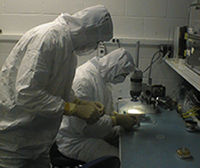 The
diamond target is inspected after assembly. Technicians are
surprised by the color of the C13 diamond segments. Having
worked with Raytheon's isotopically normal diamonds before,
they expected the Raytheon-produced quadrant to be transparent.
They suspect the dark appearance is caused by very minor impurities
of boron, which will not cause problems for the solar wind
sample collection procedure. The
diamond target is inspected after assembly. Technicians are
surprised by the color of the C13 diamond segments. Having
worked with Raytheon's isotopically normal diamonds before,
they expected the Raytheon-produced quadrant to be transparent.
They suspect the dark appearance is caused by very minor impurities
of boron, which will not cause problems for the solar wind
sample collection procedure.
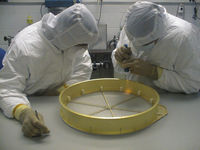 After
the target is completed, the electrostatic grid that will
cover the concentrator is inspected. This looks like a very
fine-mesh screen held inside a circular framework. The grid
is attached to the frame by spot welds, a shim ring, and screws.
Technicians are looking for obvious unevenness in the tension
of the grid material, which is also mapped microscopically. After
the target is completed, the electrostatic grid that will
cover the concentrator is inspected. This looks like a very
fine-mesh screen held inside a circular framework. The grid
is attached to the frame by spot welds, a shim ring, and screws.
Technicians are looking for obvious unevenness in the tension
of the grid material, which is also mapped microscopically.
After assembly the concentrator endured operational tests
in a vacuum chamber to simulate conditions at L1. After passing
all its tests, the Genesis concentrator was shipped from LANL
to JSC on August 23, 2000 for installation into the science
canister.
For additional technical information read "Solar Wind Concentrator"
by McComas, et al. at www.gps.caltech.edu/genesis/DocumentK.html.
|
